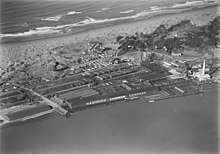Hammond Lumber Company
Hammond Lumber Company was a logging and resource extraction company operating in Humboldt County, CA.

History
In 1892, Vance Lumber Company purchased the Humboldt Bay frontage from Samoa Land and Improvement Company for construction of a large sawmill.[1] Eureka and Klamath River Railroad was chartered in 1893 to connect the Samoa, CA sawmill and associated worker housing facilities to the city of Arcata and timberlands near the Mad River. The Samoa sawmill was the largest in Humboldt County when purchased by Andrew B. Hammond in 1900.[2]
A sash and door factory was added to the mill complex by 1909,
[3] and the company was reorganized as the Hammond Lumber Company in 1912.
[4] Hammond Lumber Company built an emergency shipyard during World War I, and seven wooden steam-ships were built at Samoa between 1917 and 1919.[14] The 1921-22 Belcher Atlas of Humboldt County breaks down private and commercial land ownership throughout the county, showing that by 1922, the region of Samoa was parceled into an extractive resource industry. The largest tracts of land belonged to Hammond Lumber Company, while other enterprises included the Little River Redwood Company, the San Francisco Land Company, Big Lagoon Lumber Company, and Dolbeer & Carson Lumber Company, the latter owning the northerly marsh inlets stretching between the modern-day Arcata Bottoms and Mad River.[5] Hammond Lumber Company railroads brought logs and lumber to Samoa from company outposts on the Little River and Big Lagoon until the railway trestles were destroyed by wildfire in 1945.[6]
The Hammond-Little River Redwood Company, Ltd. was formed in a 1931 merger with Hammond Lumber Company. This resulted in the former Little River Redwood Company transferring control of former company towns to Hammond Lumber, such as with Crannell. The Humboldt Northern Railway connection to Samoa was dismantled in 1948.[7]
Hammond became a subsidiary of Georgia-Pacific Corporation in 1956.[6] After Georgia-Pacific was ordered to break up to a ruling with the Federal Trade Commission, it became incorporated as Louisiana Pacific in 1973. L-P was headed by Harry Merlo and would be based out of Portland, OR for the next 33 years, moving to Nashville in 2004.[6]
References
- Carranco (Lynwood) Papers, Series: Redwood Lumber Industry (1982). Arcata, CA: Humboldt State University Special Collections, Humboldt State University.
- Carranco (Lynwood) Papers, Series: Redwood Lumber Industry (1982). Arcata, CA: Humboldt State University Special Collections, Humboldt State University.
- Carranco (Lynwood) Papers. Arcata, CA: Humboldt State University Special Collections, Humboldt State University.
- Boyle Photograph Collection. Arcata, CA: Humboldt State University Special Collections, Humboldt State University.
- Belcher Atlas of Humboldt County. Arcata, CA: Humboldt State University Special Collections, Humboldt State University.
- "Samoa". timberheritage.org. Timber Heritage Association. 2018. Retrieved 24 April 2020.
- Carranco (Lynwood) Papers. Arcata, CA: Humboldt State University Special Collections, Humboldt State University.